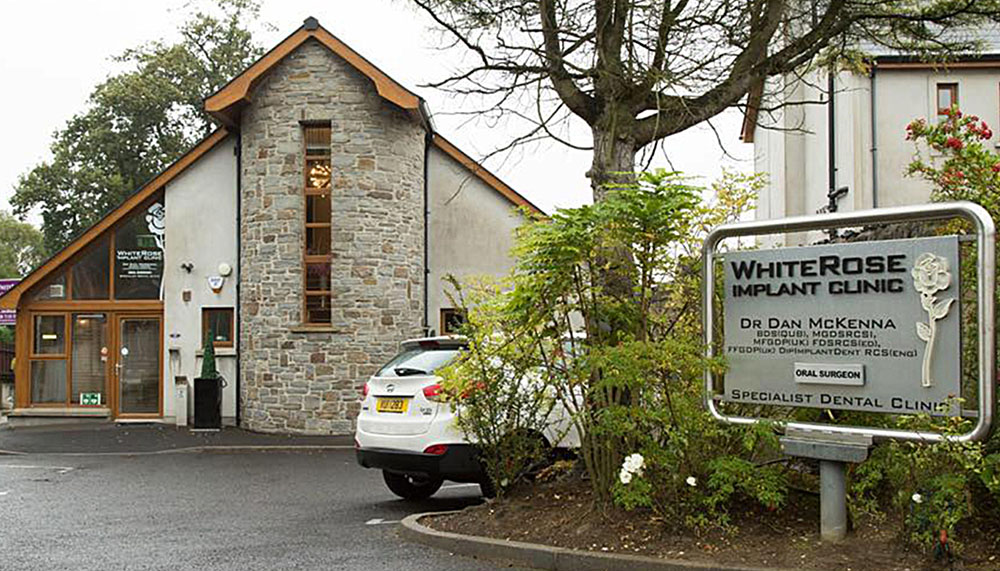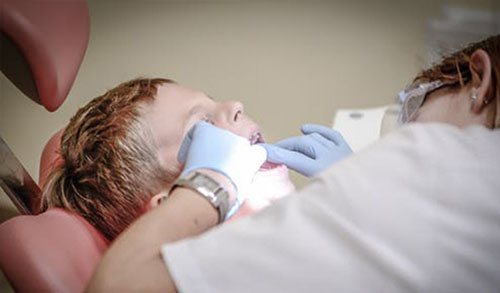
His Referral Implant and Oral Surgery Clinic and home are set in a secluded one acre site with breathtaking views over the harbour in Lough Foyle. He is passionate about his job and his enthusiasm and commitment are infectious. Perhaps it is the clear air that is conducive to the clear thinking that is so evident in Dan’s approach to dentistry. There is a calm, ordered logic that epitomises the careful planning and preparation Dan puts into patient treatment, research and training.
Dan was at Trinity College, Dublin before moving on to Queens University, Belfast. He gained his Fellowship with further studies at the Royal College of Surgeons in Edinburgh and became a specialist in oral surgery. He then received his diploma in Implant dentistry at the Faculty of Dentistry at the Royal College of Surgeons of England set up by Dr Ashek Sethi. This gave him an excellent foundation for future teaching and the diploma was accepted by the GDC.
“I have been extremely fortunate to work with and learn from some very experienced operators” says Dan, “Those include Dr Hilt Tatum on sinus grafts, ridge augmentation and various implant modalities, Professor Michael Chanavas on anatomy, CT and MRI scanning, Professor Leonard Linkow on blade and subperiosteal implants and Dr Ralph Roberts for enlightening me on the use of ramus frames and blades, Dr Palo Malo for his concept on All on 4 and Professor Chantal Malevez for her teaching on the Zygomatic implant system. These experiences of learning from others have motivated me to teach, set up my clinic and provide treatments best suited for my patients.”
With such a pedigree, you might expect Dan’s dental philosophy to have a distinct academic edge. It is, however, deceptively simple and practical:
“First, do no harm”.
PRACTISING WHAT YOU PREACH
“One of my main aims”, explains Dan, “is trying to educate patients in oral health and give up smoking. In my experience the majority of restored cases have been in patients with periodontal problems. It is of paramount importance to maintain oral hygiene around implants to prevent their loss”.
Three dental hygienists are employed to reach these goals educating and teaching patients prior to, during and after implant placements.
Dan has his hygienists spend longer sessions on new patients requiring implants or large restorative cases as needed. He calls this ‘Perio Detox’ and the patient is guided through the procedures they should carry out at home. Edentulous patients are included and they are also shown denture care, tongue cleaning, audio-visual aids, promoting prevention in this ‘see, show and do’ programme.
This was also the subject of his thesis (MPhil) under Professor Ed Lynch in the use of ozone on peri-implant mucositis in order to reverse these changes and prevent its progression to peri-implantitis with associated bone loss. The study was to attempt to establish a novel, future, simple and standard treatment in implant practices for implant maintenance.
“It has always been my opinion that research can be carried out in general practice where the vast majority of patients are seen and treated. This could be better achieved if the pathway were simplified for the general practitioner” is Dan’s view.
In working with referring dentists, Dan believes in a team effort to maintain the patient’s oral health. This entails a regular and systematic audit of the patient’s progress (something the GDC would like to see put in place).
Dan’s suggested programme is that, following implant placement, the patient has 3 monthly hygienist appointments and 6 monthly dentist appointments with the general practitioner. The referral practice should see the patient at least once a year and carefully monitor progress.
“Without this kind of protocol”, believes Dan, “you are risking an accumulation of plaque and inflammation around the implant. You also risk occlusion problems, overloading and gum disease. It would be considered good dental practice to have this team approach and follow up procedures to manage the changing dentition with time.”
TRAINING OTHERS
Along with Dr Mark Diamond (a specialist in oral surgery and Fellow of the International congress of Oral Implantologists), Dan runs a series of implantology courses at his practice in Londonderry and Mark’s practice in Belfast. The courses are run in conjunction with Dentsply (Friadent) and NobelBiocare.

The attraction to Londonderry may be because it has a picturesque location on the banks of Lough Foyle. And with its closeness to Lough Swilly in Donegal it offers the benefits of both geographical sides of this border town. It is certainly idyllic, but the facilities and equipment available to delegates are also first class.
The most recent addition is the Picasso 3 in 1 CT scanner from E-WOO Technology and Dan is delighted with the investment he has made. It includes O.P.G, I.O.P.A X-ray sensors and a cordless I.O camera.
“I looked at many CT scanners and chose the Picasso for its safety of the cone beam, its compact size, user friendliness and compatibility with Software of Excellence and NobelGuide”, says Dan. “Our clinic is a one-stop-shop for patients looking for evolutionary treatments which allow us to transfer virtual extraoral planning into the mouth with unrivalled accuracy and ease”.
Placement of the implant, abutment and restorative crown or bridge is simultaneous. The CT information enables the laboratory to produce a surgical template which guides the flapless procedure from the start to a completed restoration in the same session. The big advantage of using guided surgery is that the main part of the job can be done without having the patient present. Being flapless, surgery is less invasive and more acceptable to the patient – and there is the advantage of immediate teeth and function.
“I don’t know if E-WOO is aware of it”, remarks Dan “but Pablo Picasso himself once asked ‘Are we to paint what’s on the face, what’s inside the face, or what’s behind it?’ We can answer these questions from the slices provided by the Picasso scanner. For me it helps measure bone quality and quantity, reduces surgery time, helps avoid the risk of sensitive structures, has a low radiation exposure (25-60) μsv and gives a true OPG compared to a reconstruction image. From an oral surgery viewpoint it helps in the surgical management of removing impacted teeth, roots, apical areas and pathological conditions”.
THE IMPORTANCE OF PLANNING
In the way that great sports people make their game look simple, Dan’s approach to dentistry is deceptively simple too. Behind his fundamental belief that you do nothing until you have created ‘a stable mouth’, is an ongoing process of study and improvement.
For Dan, planning treatment first requires a realistic assessment of the patients pathological condition and treatment of perio, crowns and decay. He feels that it is ‘too easy’ to do implants and he, like others, is concerned about the medico-legal aspects of inexperienced implant placement.
At Whiterose Clinic, a patient’s oral condition has to meet strict criteria before that ‘stable mouth’ is pronounced suitable for treatment. Much of this assessment, of course, relates to the patient’s periodontal state and/or levels of endodontic treatment previously undertaken.
“It is essential to have a stable periodontal state which is maintainable by the dentist and the patient before surgery”, says Dan. “For cases requiring NobelGuide, I allow full healing of the ridges before hand. There are cases when immediate implants are placed after extracting periodontally involved or traumatised teeth and they are successful as long as the criteria are established and adhered to.”
Dan has used a range of treatments past and presently available to tackle periodontal disease (in addition to scaling and debridement). He lists Photo Activated Disinfection, Diode Laser, Scaling with saline and 4ppm ozonated saline, antimicrobial gels, scale and polish with dual antibiotics given systemically, HealOzone with or without hydrogen peroxide, TherO3zone 4ppm ozonated saline wash and LOGO3 Primodent ozone delivery system. Additionally invasive hard and soft tissue surgical treatment with bone augmentation is an option if the condition necessitates it.
Dan has recently completed a world first double blind randomised controlled clinical trial where he has shown how Ozone can manage peri-implantitis. Dan recommends the use of his unique concept of ozonating saline in the excellent USA product called TherOzone from LA. Dan has proven how ozone (which is the most powerful antimicrobial agent we can use in dentistry as well as being the most potent oxidant we can use) has the unique potential to save implants from peri-implantitis. Dan has already presented this research to the European annual meeting of the International Association for Dental Research.
As far as endo treated teeth are concerned, Dan is always concerned about longevity.
“I see a case of a root filled tooth, vertically fractured, almost every month” he says “and if this is not restored swiftly it will cause associated bone loss and increase the difficulty of placing an implant without the need for bone augmentation”.
Dan also points out that, by their very nature root filled teeth have less durability and that the majority of post crowned teeth are compromised. He quotes A Clinical Survey of failed crowns… Lewis R & Smith BGN BDJ 1988; 165:95 – 97. “The mean lifespan of a post retained crown was 4.2 years. 66% failed within 3 years of cementation”.
“My implant success rate is 98% and their longevity is better than many natural teeth heavily restored with bridgework, they last as long as they are well looked after”, claims Dan.
Again Dan finds the Picasso helpful for endoscopy, because it gives a guided tour up root canals and the inferior dental canal, bone density measurements, sagittal, coronal, axial, rotating 3D images and soft contours of the face, lips and chin. This all helps with case planning.
AND TOMORROW?
Once again, Dan’s philosophy is uncomplicated.
“I shall continue to go to Co Donegal for fly fishing and clay pigeon shooting. I shall enjoy boating on Lough Swilly and off-shore to Scotland and Tory Island. And I shall invest in C.P.D within the profession which in turn allows the benefits of dental knowledge updates to be passed onto the patient”.
| PUBLISHED IN: | Dentistry, February 2009 |
| DENTIST: | Dr. Dan McKenna |
| EQUIPMENT: | Picasso-Trio |
| DENTAL PRACTICE: | Whiterose Clinic |
| ADDRESS: | 7 Culmore Point Road, L’Derry North Ireland BT48 8JW |
| TELEPHONE: | 01279 871 724 |
| EMAIL: | info@whiteroseclinic.com |
| WEBSITE: | whiteroseclinic.com |